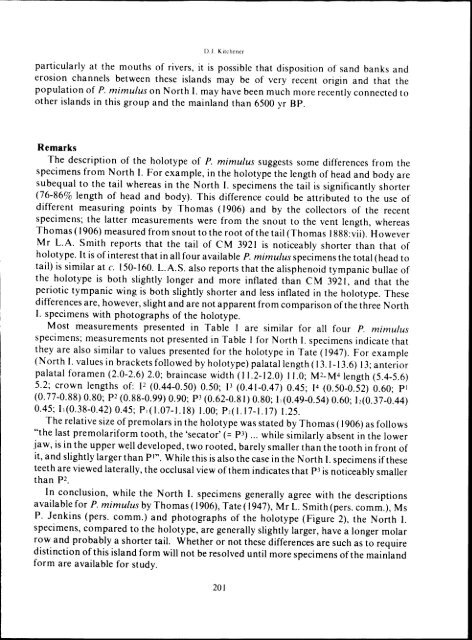Pseudantechinus mimulus (Thomas, 1906) (Marsupialia: Dasyuridae)
Pseudantechinus mimulus (Thomas, 1906) (Marsupialia: Dasyuridae)
Pseudantechinus mimulus (Thomas, 1906) (Marsupialia: Dasyuridae)
Create successful ePaper yourself
Turn your PDF publications into a flip-book with our unique Google optimized e-Paper software.
DJ. Kltchenel<br />
particularly at the mouths of rivers, it is possible that disposition of sand banks and<br />
erosion channels between these islands may be of very recent origin and that the<br />
population of P. <strong>mimulus</strong> on North I. may have been much more recently connected to<br />
other islands in this group and the mainland than 6500 yr BP.<br />
Remarks<br />
The description of the holotype of P. <strong>mimulus</strong> suggests some differences from the<br />
specimens from North I. For example, in the holotype the length of head and body are<br />
subequal to the tail whereas in the North I. specimens the tail is significantly shorter<br />
(76-86% length of head and body). This difference could be attributed to the use of<br />
different measuring points by <strong>Thomas</strong> (<strong>1906</strong>) and by the collectors of the recent<br />
specimens; the latter measurements were from the snout to the vent length, whereas<br />
<strong>Thomas</strong> (<strong>1906</strong>) measured from snout to the root ofthe tail (<strong>Thomas</strong> 1888:vii). However<br />
Mr L.A. Smith reports that the tail of CM 3921 is noticeably shorter than that of<br />
holotype. It is ofinterest that in all four available P. <strong>mimulus</strong> specimens the total (head to<br />
tail) is similar at c. 150-160. L.A.S. also reports that the alisphenoid tympanic bullae of<br />
the holotype is both slightly longer and more inflated than CM 3921, and that the<br />
periotic tympanic wing is both slightly shorter and less inflated in the holotype. These<br />
differences are, however, slight and are not apparent from comparison ofthe three North<br />
I. specimens with photographs of the holotype.<br />
Most measurements presented in Table 1 are similar for all four P. <strong>mimulus</strong><br />
specimens; measurements not presented in Table I for North I. specimens indicate that<br />
they are also similar to values presented for the holotype in Tate (1947). For example<br />
(North I. values in brackets followed by holotype) palatal length (13.1-13.6) 13; anterior<br />
palatal foramen (2.0-2.6) 2.0; braincase width (11.2-12.0) 11.0; M2-M 4 1ength (5.4-5.6)<br />
5.2; crown lengths of: J2 (0.44-0.50) 0.50; P (0.41-0.47) 0.45; 14 (0.50-0.52) 0.60; pi<br />
(0.77-0.88) 0.80; p2 (0.88-0.99) 0.90; p3 (0.62-0.81) 0.80; 11(0.49-0.54) 0.60; 12(0.37-0.44)<br />
0.45; b(0.38-0.42) 0.45; PI(1.07-1.18) 1.00; P2(1.l7-1.17) 1.25.<br />
The relative size of premolars in the holotype was stated by <strong>Thomas</strong> (<strong>1906</strong>) as follows<br />
"the last premolariform tooth, the 'secator' (= P3) ... while similarly absent in the lower<br />
jaw, is in the upper well developed, two rooted, barely smaller than the tooth in front of<br />
it, and slightly larger than PI". While this is also the case in the North I. specimens ifthese<br />
teeth are viewed laterally, the occlusal view ofthem indicates that p3 is noticeably smaller<br />
than P2.<br />
In conclusion, while the North I. specimens generally agree with the descriptions<br />
available for P. <strong>mimulus</strong> by <strong>Thomas</strong> (<strong>1906</strong>), Tate (1947), Mr L. Smith (pers. comm.), Ms<br />
P. Jenkins (pers. comm.) and photographs of the holotype (Figure 2), the North I.<br />
specimens, compared to the holotype, are generally slightly larger, have a longer molar<br />
row and probably a shorter tail. Whether or not these differences are such as to require<br />
distinction ofthis island form will not be resolved until more specimens ofthe mainland<br />
form are available for study.<br />
201
















